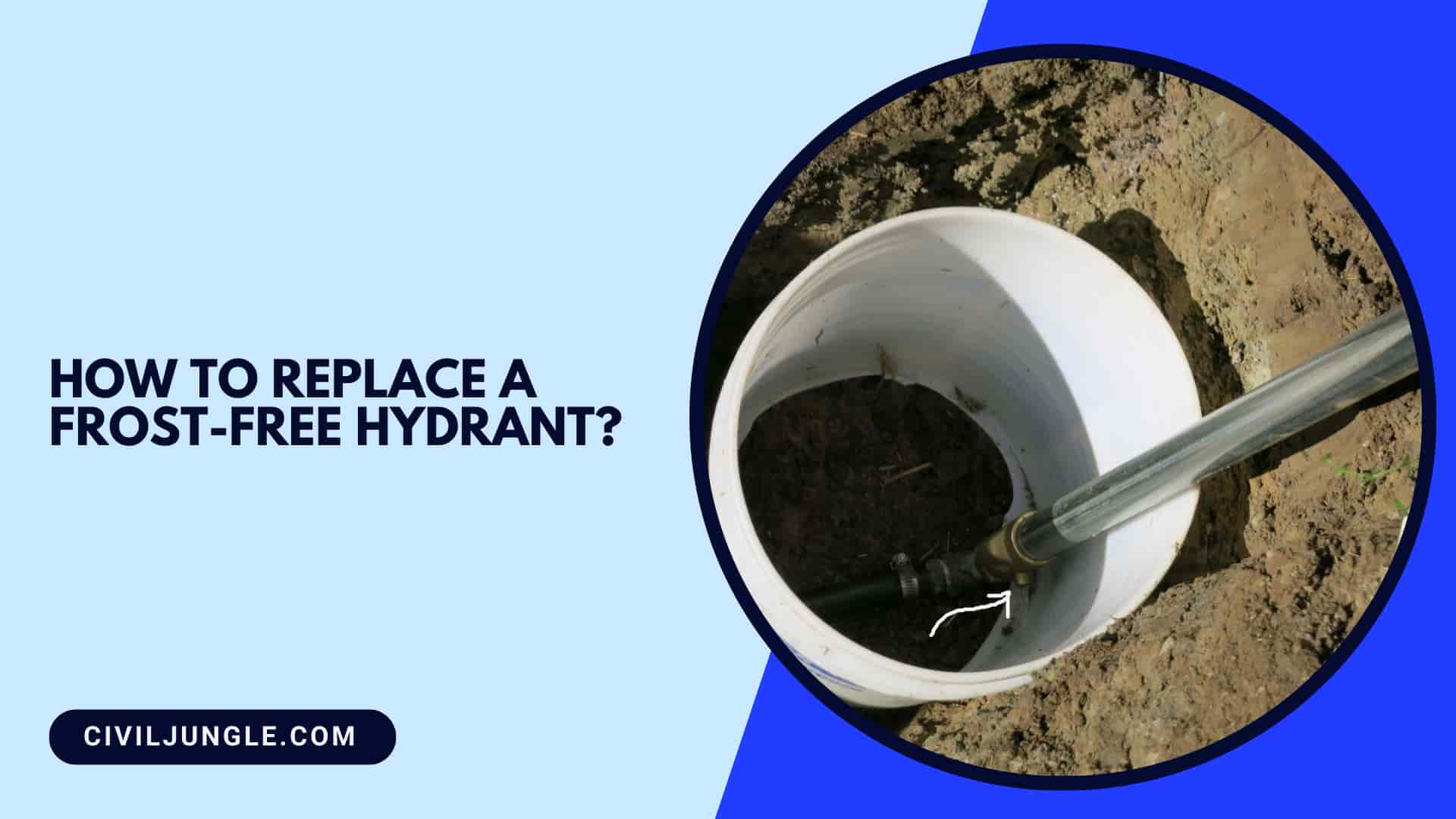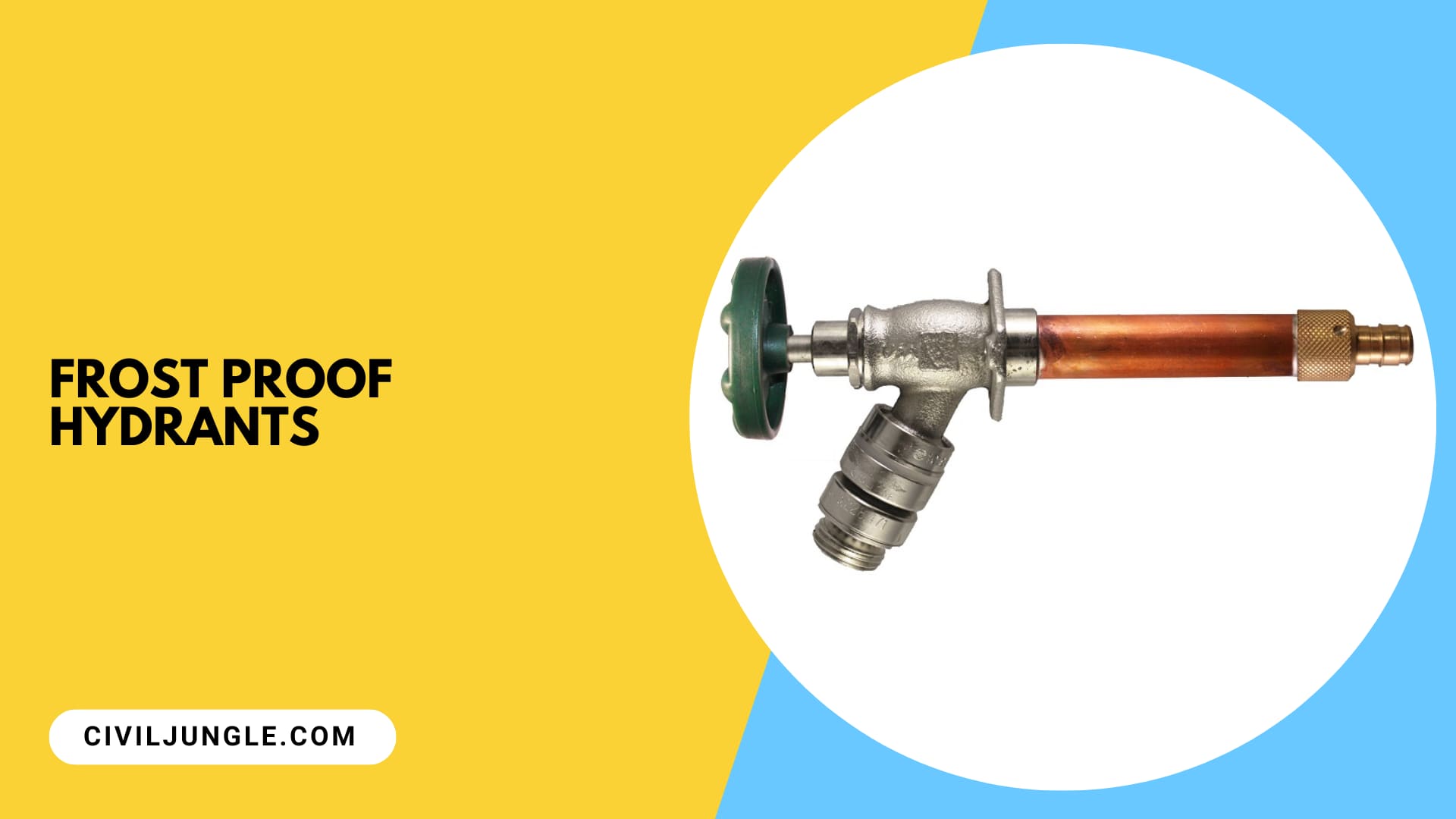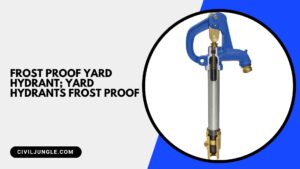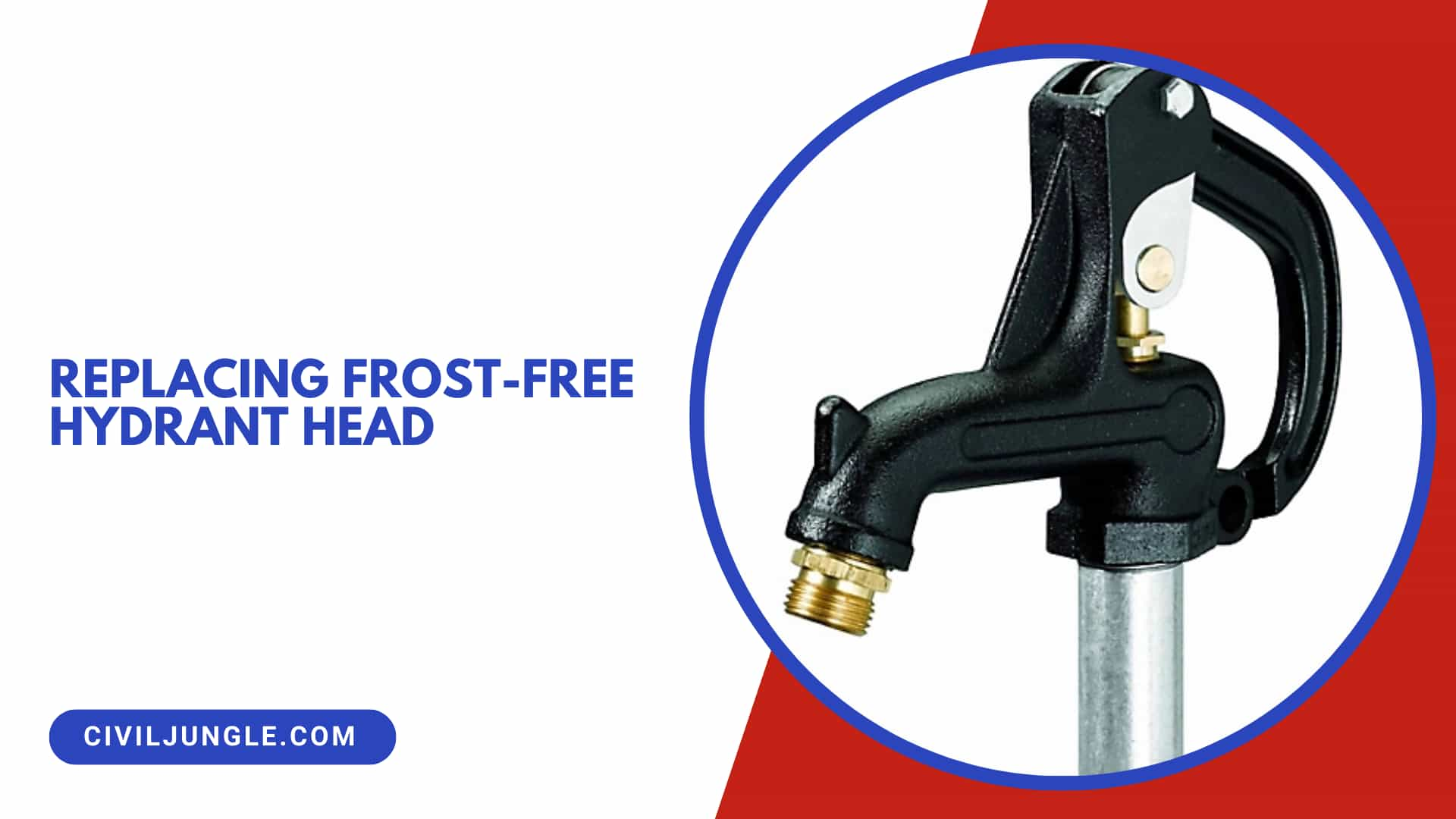How to Replace a Frost-Free Hydrant?
Important Point
The need for frost-free hydrant installation occurs when water is to be accessed at a location that is quite far away from your home or it can be in an area that might be at a far distance from your home.
It is also required in areas that will require outside water throughout the year which will experience freezing water temperatures.
The steps for replacing a frost-free hydrant are as follows:
Dig Out the Old Hydrant
First, shut off the supply of water to the hydrant after that you should open the faucet of the hydrant for removing extra pressure in the line.
Use a standard shovel to dig a hole around the hydrant for exposing the sandpipe in order to prevent any damage to the pipe.
You must remove enough soil and gravel around the fitting at the bottom of the standpipe for having sufficient room to work.
Remove the Old Hydrant
After the above step unscrew the sandpipe from the fitting, you can use two pipe wrenches, use one of them for holding the fitting in place so that it will not be twisted or not able to move, after that use another wrench to twist the sandpipe in a counterclockwise direction.
If you find it difficult to open the wrench you can soak the threads of the pipe with the help of penetrating oil for example you can use Liquid Wrench or WD-40.
Allow the oil to absorb for 15 to 30 minutes after that you must be able to remove the pipe.
If required repeat the oil application again. You must be careful that dirt or gravel does not fall into the pipe fitting while the standpipe is removed.
If by chance anything falls you can use a vacuum for removing it or by allowing the water to flow for some time in order to remove the debris out of pipe debris.
Install the New Hydrant
Now apply the plumber’s tape or the pipe-joint compound to the threads of the standpipe of the new hydrant.
After that, you must thread the standpipe into the underground fitting again with the help of two pipe wrenches. One of them to hold the fitting and another one for turning the pipe.
After that tighten the standpipe properly, you have to stop when the faucet will face in the desired position. You must not over-tight the standpipe.
Test the New Hydrant
Now turn on the water supply of the hydrant then properly check whether there are any loose connections which can lead to leakage.
You can test the hydrant with the help of a hose pipe attached to it and properly position the end of the hose well away from the hole of the hydrant after that open the faucet of the hydrant.
Make an arrangement so that the water from the standpipe properly drains out through the drain valve at the base of the standpipe.
Backfill the Hole
Up to a height of 3 inches begin filling the hole with the help of ½ inch diameter drainage gravel.
This will ensure that water that is draining from the standpipe will now flow away from the valve.
After that fill the remaining portion of the hole with the help of soil and then compact it with the help of your feet.
How Does a Yard Hydrant Work?
A yard hydrant will consist of a pump-like metal faucet head that will be connected to a long, metal standpipe that will extend deep into the ground.
In a trench, a cold-water pipe runs horizontally from a source to the base of the hydrant’s standpipe.
The hydrant’s handle helps in controlling and operating the rod that will run through the standpipe it will have a rubber plunger at its bottom end.
The plunger will fit into a valve seat it is much like that of a valve on a compression-style faucet.
Lift of the hydraulic handle helps in raising the plunger which will allow the flowing up of the standpipe and then flow through the faucet spout.
After you lower the handle it helps in stopping the flow of water in an upward direction to the standpipe.
A drain port will open when the plunger will be in a closed position which will allow the remaining water in the standpipe to properly drain into a bank of gravel which will then go into the surrounding soil.
This will help in preventing the water to freeze inside the standpipe. The standpipe helps to drain automatically with the help of the force of gravity.
With the draining of water, it will draw in air through the spout of the hydrant. So, this is the reason why you have to remove a hose that is connected to the spout when you can expect freezing temperatures to occur.
If you leave the hose connected helps in preventing air from entering the spout which will prevent the hydrant to drain out and this might lead to a frozen standpipe.
Also, Read: Types of Kitchen Faucets
Cost to Replace Outdoor Faucet
For replacing an outdoor faucet, the cost ranges from about $100 to around $300, the cost averaging to around $175.
The part of the outdoor faucet will cost you $10 to around $60 and an additional labor cost o $150 to $200 per hour when you will be replacing the outdoor faucet.
While if you consider the pricing based on the types of the outdoor faucet available the pricing will be different for different faucets.
Also, Read: Top 10 Bathroom Fittings & Sanitary Brands India: August 2023
Traditional Spigot, Sillcock, or Outdoor Faucet Pricing
This type of faucet will range between $5 to around $15 but some special items will range up to $170.
Frost-Free Faucet Pricing
This type of faucet will cost you $35 or if expensive items are bought the price will go up to $200.
Anti-Siphon Faucet pricing
It will cost you around $45 to around $300 when you need to replace it.
Yard Hydrants
These are used in frigid temperatures if you replace these faucets it will cost you $800.
Ball-Value Faucet pricing
This faucet will have an average pricing of around $30 when replaced.
Doing the replacement might cost you less than hiring a professional for the job but while you do the job you will face very difficulties.
Useful article for you
- How Much Does a Yard of Concrete Weigh
- How Tall Is a Door
- How Many Stairs in a Flight
- How Many Bags of Concrete in a Yard
- How to Get Burnt Smell Out of Microwave
- How Far Apart Should Fence Posts Be
- How Are Bridges Built Over Water
- How Many People Died Building the Great Wall of China
- How to Draw House
- How to Build a Lean to Roof
- How Many Bags of Concrete for 1 Yard
- How Much Does Cinder Block Cost
- How to Get a House for Free
- How Much Does It Cost to Soundproof a Room
- How to Read a Measuring Tape in Meters
- How to Mount a TV on a Brick Wall
- How Many Brick Are in a Cube
- How Is Transported Soil Different from Residual Soil
- How to Use Washers
- How to Get Property for Free
- How Is Tar Made
- How Much Does Gallon of Water Weight?
- How Many Tiles Do I Need?
- How Much Does It Cost to Build a Pergola?
- How Much Does a Concrete Slab Cost?
- How Much Does a Yard of Gravel Weigh?
- How Many Shingles Do I Need for a 24×24 Garage?
- How to Remove Paint from Concrete Without Chemicals
- How to Cover Concrete Walls in Basement
- How to Find Wall load
- How to Build a Cavity Wall
- How Much Does a Heated Driveway Cost
- How Much Spray Foam Do I Need
- How to Get Blood Out of Carpet
- How to Mix Concrete
- How to Kill Tree Roots
How Does a Frost-Free Hydrant Work?
A frost-free hydrant is just a simple variation of a standard compression faucet which will have a plunger at the end of the plunger stem which will open and close against an inlet of water in order to control the flow of water.
You can think frost-free hydrant as a very long compression faucet.
You must bury deep enough the horizontal water pipe so that it gets below the frost line, the hydrant pipe is running out of the hydrant location.
In many climates, it will be required to bury below 4 feet or rather deeper. At the point where the horizontal pipe is turned upward into a vertical standpipe, you will notice that the actual valve will be located.
A standard 1-inch diameter pipe is used which is a galvanized one it will be threaded at the top.
The hydrant head will be screwed onto the pipe at the top of the standpipe which is generally 3 to 4 feet above the ground.
A fulcrum-type lever is used for the faucet which is used to raise and lower a long pump rod that is inside the standpipe which is why it is a special type of faucet.
A plunger is fitted at the bottom end of the pump rod having a rubber washer or seal which is fitted at its end.
The valve will be designed in such a way that if the handle of the hydrant is lowered the pump rod and plunger gets squeezed down onto an inlet of water which then stops the water flow.
If you raise the handle of the hydrant it will lift the plunger up away from the water inlet which in turn will allow the flow of water up to the standpipe and then out of the spigot.
Frost Free Hydrant
A variation if made to the standard compression faucet then it is known as a frost-free hydrant. Here a plunger at the end of a plunger stem will open and close against a water inlet so that it can control the flow of water.
While in the case of the yard hydrant, the plunger will be fitted into the end of a long pump rod which will run down inside a vertical standpipe to the body of the valve.
You might require a long pump rod because it is required to send the rod to the water pipe which is essential.
A frost-free hydrant will contain a horizontal pipe that is buried in the ground, it will lead to a vertical pipe that will be 24 inches deeper underground known as a standpipe.
The standpipe will automatically help in draining the water from the hydrant when the hydrant will be shut off.
Frost Proof Hydrants
A frost-proof hydrant is a plumbing product that will drain water from the ground preventing it to freeze out.
Due to its nature of pumping water from the bottom to the top, it is also known as a water pump. This hydrant will help in providing non-frozen water throughout the year.
The yard hydrant has a structure that is quite easy to understand. On the top the head of the hydrant is present.
Alongside a hydrant is present. In order to start the flow of water the handle is to be lifted.
After that the hydrant will be operational after that after that for stopping the flow of water you will have to pull the handle down.
A considerable length is to be buried inside the ground for the first proof yard hydrant. From this point, water will be drained under the frost line.
- These types of yard hydrants are installed in open areas.
- They are used in houses, farms, gardens, etc.
- The frost-proof hydrant works similarly to that of a water pump.
Water Hydrant Frost Free
A variation in the compression faucet with a plunger opening and closing makes a water hydrant frost free.
A horizontal pipe will lead to a vertical pipe known as a standpipe. There should be no hoses attached to the head casting.
When you shut off the water on a water hydrant frost free behind the valve the water will stop behind a valve that will be much further behind the home.
As the water is in an interior position the temperature will be warm and prevent the water from freezing.
A frost-free hydrant is designed in such a way that the pipe will extend through the house’s sidewall and along with a combination of flow valves is kept inside the heated interior so it helps in preventing freezing.
Useful Article For You
- Landscaping App Free
- Cost to Build a House Calculator Free
- Free Construction Estimating Software Excel
- Kitchen Remodel App Free
- House Building Cost Calculator Free
- Free Materials List for Building a House
- Freeze Depth by Zip Code
- Free Plans for 3d Cutting Boards
- west point bridge designer 2023 free download
- Free Form Concrete
- Free Vastu Tips for Home
- Formaldehyde Free Bamboo Flooring
- Civil Engineering Software Free
- Free Shed Plans
- Free Building Materials
- Free Standing Patio Cover Plans Pdf
Frost Proof Yard Hydrant; Yard Hydrants Frost Proof
These are definitive compression water fixtures used outdoors.
- For typical freezing environmental temperatures these are used, it is also known as a water pump.
- Although it is operated with the help of a hose connector and the control level is kept above the ground.
- The operating valve is kept under the ground at a place where freezing conditions will not occur.
- The freeze-proof yard hydrant has a design that helps in permitting to drain the water and prevent freezing in winter.
- If not properly installed it will create problems.
- They are quite beneficial for nurseries or for farmers and it helps in preventing the need for carrying garden hose quite far.
Replacing Frost-Free Hydrant Head
The hydrant head is required to be replaced sometimes if some damage occurs or the replacement of the plunger is required.
The steps for replacing a hydrant head are to loosen the stainless-steel set screw in order to allow free movement of the 3/8” stainless steel operation rod in the zinc-plated pivot connector.
After that, you will have to loosen the ¾” brass packing nut up to the point pressure is not getting applied on O-Ring seals since it is much better to remove it completely rather than to put pressure on O-Rings since that would result in turning of operating rod with loosening of head casting and allowing the stainless-steel operation rod to get turned freely from the head casting.
After that try to remove the head casting by turning the head casting counter in a clockwise direction by the use of a pipe wrench.
After making the galvanized stand pipe free from the head casting by applying 3 to 4 full revolutions try to pull the head casting upright.
Now you will be able to replace the head. You must make sure that the ¾” brass packing nut is loosened and is not putting pressure on the O-ring seals so that the stainless-steel rod slides freely through the O-rings.
Now lower the head casting downward so that the rod slides properly through the O-ring and brass packing.
Apply the tape when the head casting is toughing the galvanized standpipe. You have to turn the head casting in a clockwise direction after that using a pipe wrench to tighten it properly.
Then properly tighten the brass packing nut until it will put pressure on the O-ring seals but do not apply extra pressure.
How Does a Yard Hydrant Work?
The top casted piece of a yard hydrant can come in many shapes and sizes, yet all serve the same basic purpose. They have a handle that when pulled up, will lift either the rod or the wet pipe (depending on the style of hydrant) allowing water to flow through the valve, up the vertical pipe and out the hydrant head.
Yard Hydrant Installation
- Dig hole for hydrant approximately 2 feet in diameter and deeper than the bury depth.
- Flush gravel, debris, etc.
- Install hydrant with drain hole below frost line.
- If supply line to the hydrant will not support hydrant, use re-bar, length of pipe or other suitable support driven in bottom of pit to help support hydrant.
What Are the 4 Types of Fire Hydrant?
These types include: Dry-Barrel Hydrants, Wet-Barrel Hydrants, Warm-Climate Hydrants, and Flush Hydrants.
How Deep to Bury Frost Free Hydrant?
Frost depths can vary around the United States from 0 to 8 feet deep, and hydrants come with standpipes designed for “bury depths” of 1 foot to 5 feet or more. Your yard hydrant’s head should be a minimum of 24 inches tall and may go up to 30 inches above ground level.
Can Frost Free Hydrants Freeze?
It is a potentially major problem. This is because a dripping frost free hydrant is no longer frost free. The above ground portion is filled with water and will freeze and potentially burst in cold weather.
How Much Does It Cost to Replace an Outdoor Faucet?
Having a professional install a typical outdoor faucet can cost as little as $100, with the national average cost being $500. If you’re looking for something more complex, you’ll pay based on the cost of materials and the complexity of the project, which could tally up to $4,000 or more.
How Much Does It Cost to Replace a Hose Bib?
On average, you could replace a basic hose bib yourself for between $20 and $50. If you’d much rather hire professionals, add labor costs to those expenses and you will end up spending between $150 and $300.
How Much Does It Cost to Replace an Outdoor Spigot?
Spigot installation typically ranges between $150 and $500, with $325 being the median cost. The two most common types of outdoor spigots are the hose bib and the ball valve, which both cost between $150 and $300.
How Much Does It Cost to Replace Outside Faucet?
Having a professional install a typical outdoor faucet can cost as little as $100, with the national average cost being $500. If you’re looking for something more complex, you’ll pay based on the cost of materials and the complexity of the project, which could tally up to $4,000 or more.
How Does a Yard Hydrant Work?
The top casted piece of a yard hydrant can come in many shapes and sizes, yet all serve the same basic purpose. They have a handle that when pulled up, will lift either the rod or the wet pipe (depending on the style of hydrant) allowing water to flow through the valve, up the vertical pipe and out the hydrant head.
What Does a Black Fire Hydrant Mean?
OSHA advises using color to distinguish between potable and non-potable water sources—with violet indicating the latter—and also recommends black paint for defunct or temporarily non-working hydrants.
Like this post? Share it with your friends!
Suggested Read –
Originally posted 2023-08-11 16:50:56.











Leave a Reply